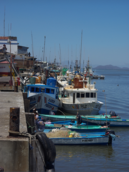Puntarenas
| Puntarenas | |||||||
|---|---|---|---|---|---|---|---|
| City and municipality | |||||||
Images, from top down, left to right: the Port Laborer Monument, Tourists Pass Avenue, The Cathedral within Central Park, Crown Princess docked at Puntarenas' Port, docked fishing boats, Puntarenas Pier.
|
|||||||
|
|||||||
| Nickname(s): La perla del Pacífico (Spanish) "The Pacific Pearl" |
|||||||
 Puntarenas and surrounding area |
|||||||
| Location of Puntarenas within Costa Rica | |||||||
| Coordinates: 9°58′N 84°50′W / 9.967°N 84.833°W | |||||||
| Country | Costa Rica | ||||||
| Province | Puntarenas | ||||||
| Canton | Puntarenas | ||||||
| Incorporated | 17 September 1858 | ||||||
| Government | |||||||
| • Type | Municipality | ||||||
| • Mayor | Rafael Ángel Rodríguez Castro (PLN) | ||||||
| Area | |||||||
| • Total | 34.34 km2 (13.26 sq mi) | ||||||
| • Land | 30 km2 (10 sq mi) | ||||||
| • Water | 60 km2 (25 sq mi) | ||||||
| Elevation | 5 m (16 ft) | ||||||
| Population (2012) | |||||||
| • Total | 34,085 | ||||||
| • Density | 990/km2 (2,600/sq mi) | ||||||
| • Demonym | Puntarenense | ||||||
| Time zone | Central (UTC-6) | ||||||
| Postal code | 60101 | ||||||
| Area code(s) | + 506 | ||||||
| Website | http://www.puntarenas.go.cr/ (Spanish) | ||||||
Puntarenas (Spanish pronunciation: [puntaˈɾenas]; Pointsands, from "punta arenas", or "sand point" in Spanish) is the capital and largest city in the Province of Puntarenas, on the Pacific coast of Costa Rica. The eponymous and oddly shaped province has its largest section in the South, far from the capital.
There are some 100.000 inhabitants in the town and surrounding neighborhoods. With beaches on the Pacific Ocean, it also attracts many tourists, especially surfers. It is also a possible stopover point for the tourist destination Monteverde, to the northwest.
Its port, Caldera, is one of the main ports, and the oldest, port in the country. There is a regular scheduled ferries to and from Puntarenas and the Nicoya Peninsula.
Puntarenas was discovered by Gil González Dávila in 1522. Despite the use of the Gulf of Nicoya as an entryway to Costa Rica's inland territory, the port of Puntarenas was not developed until 1840 when coffee production in the highlands reached exportable volumes. In 1845 the Congress of the Republic declared Puntarenas a duty-free port (with the exception of Cognac and hard liquor). Originally, the coffee was brought to port in oxcarts via a trail through the mountains. In 1859, a stretch of railway track was completed between Puntarenas and the town of Esparza (one of the country's earliest Spanish settlements, founded in 1574). Eventually, the railway was built all the way through to San José and service was inaugurated in 1910.
With the railway connection to the Central Valley, the Pacific port's activities continued to be a major part of the region's economy throughout the 20th century. However, due to the aging and deterioration of the port facilities and the need to accommodate the much larger vessels of modern shipping fleets, a new port was constructed in the 1980s to the south of Puntarenas. The site chosen was Caldera (located at 9°54′39″N 84°43′10″W / 9.9108438°N 84.7194761°W), where ships had anchored during colonial times. Caldera was more appropriate site for larger ships, and actually was the first port site used since 1522.
...
Wikipedia








